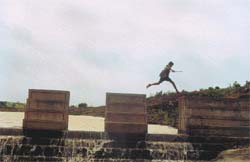Steeplechase
 Kalakhoont village's spin out of the poverty cycle began on a rainy day in June this year. Four days of rain filled up to the brim the long-forgotten tank in this nondescript village of Jhabua district in Madhya Pradesh ( mp ). Now almost the entire village is encircled by water overflowing from the tank.
Kalakhoont village's spin out of the poverty cycle began on a rainy day in June this year. Four days of rain filled up to the brim the long-forgotten tank in this nondescript village of Jhabua district in Madhya Pradesh ( mp ). Now almost the entire village is encircled by water overflowing from the tank.
Crippled by two consecutive droughts, when an ngo , Action for Social Advancement ( asa ), offered to renovate the tank, it was hard for the residents to decide to contribute 25 per cent of the tank's renovation cost of Rs 3 lakh. Three-metres of silt, which had eroded from the surrounding hills, was removed from the tank. This was used as manure in the farmlands and the tank was soon renovated.
But the decision paid rich dividends and now promises to change the lives of the villagers forever. "There is enough water for the next three years,' says an excited Nana Basna, president of the lift-irrigation society formed to regulate water use in the village. "The stored water will be enough to irrigate more than 61 hectares (ha) of land. The recharged wells will be an additional source.'
The story is repeated a stone's throw away in Datod village, where a small dam built on a seasonal river, Mod, has ended years of arid misery. Though covered under the state's watershed development mission, the village found it hard to meet its irrigation needs till asa took up the task of building the dam with voluntary participation of the people. Now water is overflowing from the dam and residents plan to revive a defunct lift irrigation point.
"Immediately three villages will be irrigated, something unheard of in this drought-stricken district,' exclaims the barefoot leader of the project, the Pitol block panchayat president Balusingh Bhuria.
The saga of successful people-centric efforts continued as Down To Earth chased the monsoon across three of the 11 drought-ravaged states
